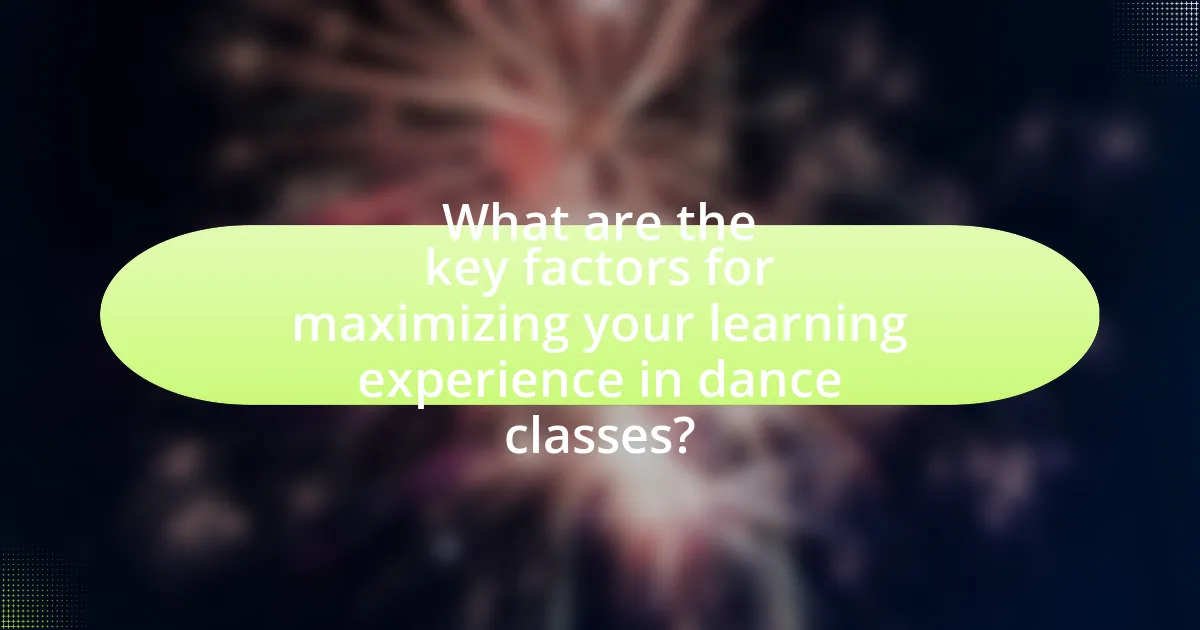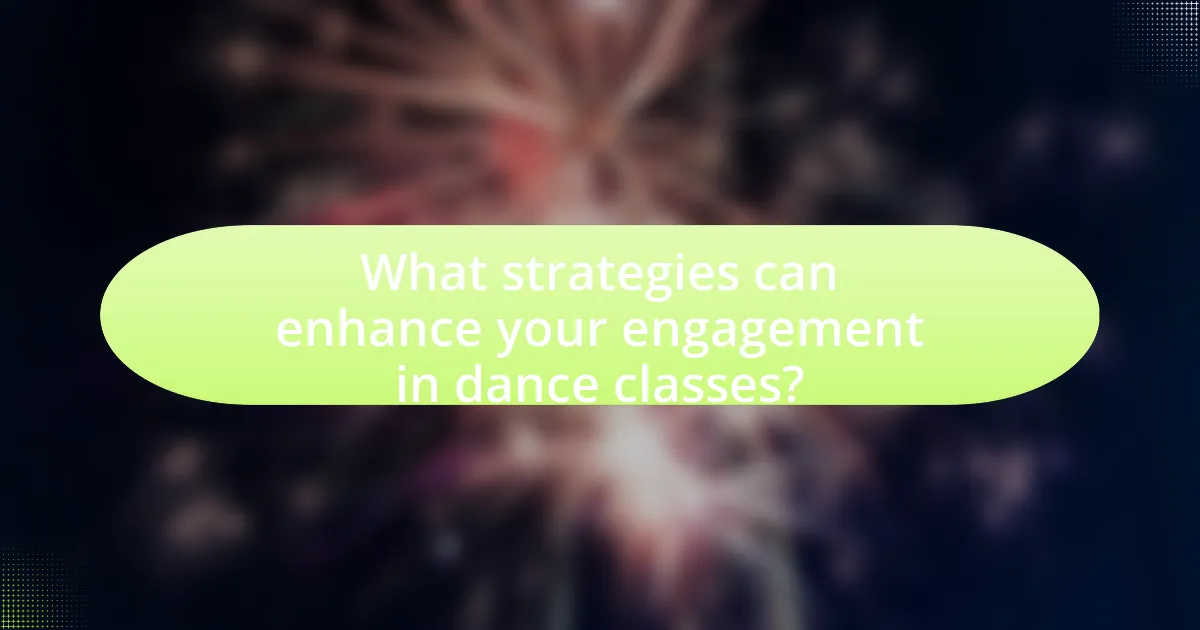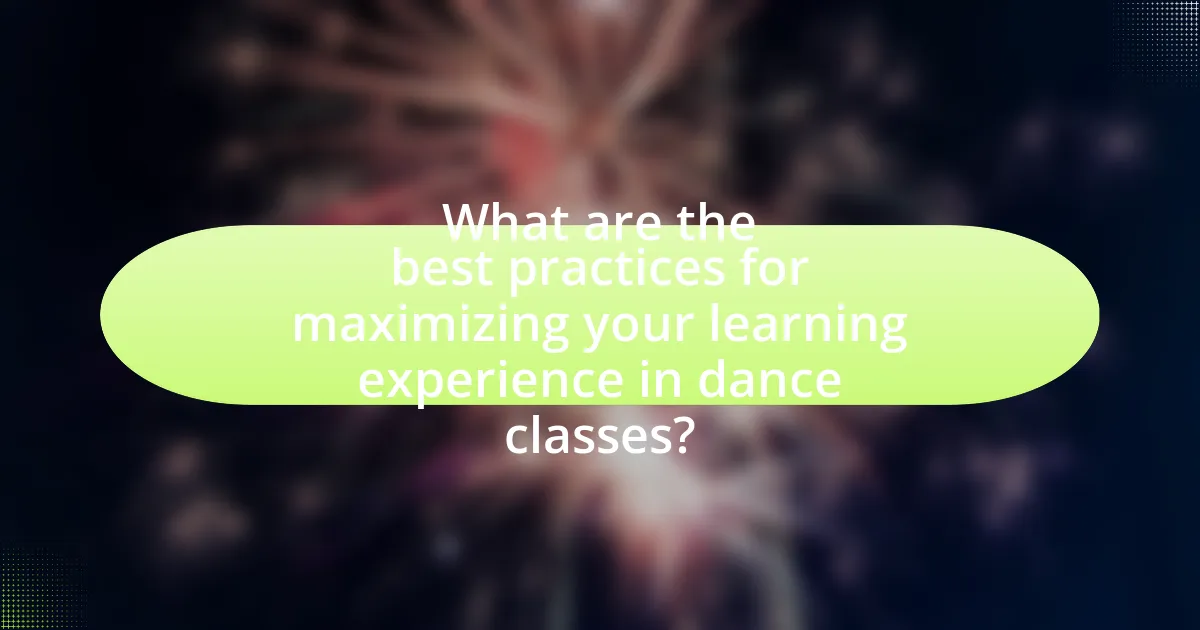The article focuses on tips for maximizing the learning experience in dance classes, emphasizing key factors such as consistent practice, effective communication with instructors, and the importance of setting clear goals. It explores how mindset and attitude influence learning, highlighting the benefits of a growth mindset and a positive outlook. Additionally, the article discusses the significance of feedback, the impact of class selection on learning outcomes, and strategies for enhancing engagement and focus during lessons. Practical tips for tracking progress and overcoming common challenges in dance education are also provided, making it a comprehensive guide for dancers seeking to improve their skills and overall experience.

What are the key factors for maximizing your learning experience in dance classes?
The key factors for maximizing your learning experience in dance classes include consistent practice, effective communication with instructors, and setting clear goals. Consistent practice reinforces muscle memory and technique, allowing dancers to progress more rapidly. Effective communication with instructors ensures that dancers receive personalized feedback, which is crucial for improvement. Setting clear goals provides direction and motivation, helping dancers to focus their efforts on specific skills or styles. Research indicates that goal-setting can enhance performance by providing a clear framework for achievement, as noted in studies on motivation in physical education.
How does your mindset influence your learning in dance classes?
Your mindset significantly influences your learning in dance classes by shaping your approach to challenges and your ability to absorb new information. A growth mindset, characterized by the belief that abilities can be developed through dedication and hard work, leads to greater resilience and a willingness to practice, which enhances skill acquisition. Research by Carol Dweck indicates that students with a growth mindset are more likely to embrace challenges, persist through difficulties, and ultimately achieve higher levels of success in their learning endeavors. In contrast, a fixed mindset can hinder progress by fostering fear of failure and discouragement in the face of obstacles. Thus, cultivating a positive and growth-oriented mindset is essential for maximizing learning in dance classes.
What role does a positive attitude play in dance learning?
A positive attitude significantly enhances dance learning by fostering an environment conducive to growth and creativity. When dancers approach their practice with optimism, they are more likely to engage fully, embrace challenges, and persist through difficulties. Research indicates that a positive mindset can improve performance outcomes; for instance, a study published in the Journal of Sport & Exercise Psychology found that athletes with a positive outlook exhibited greater resilience and adaptability, which are crucial traits in dance learning. This mindset not only boosts individual motivation but also positively influences group dynamics, leading to a more supportive and collaborative learning atmosphere.
How can setting personal goals enhance your dance education?
Setting personal goals enhances dance education by providing clear direction and motivation for improvement. When dancers establish specific, measurable, achievable, relevant, and time-bound (SMART) goals, they can focus their practice on particular skills or techniques, leading to more effective learning outcomes. Research indicates that goal-setting can increase performance by up to 25% as it fosters a sense of accountability and encourages consistent effort. By tracking progress towards these goals, dancers can also identify areas needing further development, thereby optimizing their learning experience in dance classes.
What is the importance of practice in dance learning?
Practice is essential in dance learning as it enhances muscle memory, coordination, and overall performance. Regular practice allows dancers to internalize movements, making them more fluid and natural during execution. Studies show that consistent practice leads to improved technique and confidence, as evidenced by research from the Journal of Dance Medicine & Science, which highlights that dancers who practice regularly exhibit greater skill retention and adaptability in various dance styles. Thus, practice is a critical component in mastering dance.
How often should you practice to see improvement?
To see improvement in dance, you should practice at least three to five times a week. Consistent practice within this frequency allows for muscle memory development, skill refinement, and increased confidence. Research indicates that regular practice enhances retention and performance, with studies showing that individuals who engage in frequent practice sessions demonstrate significantly better progress compared to those who practice less frequently.
What types of practice are most effective for dance skills?
Repetitive practice, also known as deliberate practice, is the most effective type of practice for developing dance skills. This method involves focusing on specific movements or techniques repeatedly to enhance muscle memory and precision. Research indicates that deliberate practice leads to significant improvements in performance, as it encourages dancers to identify and correct mistakes in real-time, thereby refining their skills. A study published in the Journal of Dance Medicine & Science highlights that dancers who engage in structured, focused practice sessions show greater advancements in their technical abilities compared to those who practice without a clear goal or structure.
How does the choice of dance class affect your learning experience?
The choice of dance class significantly affects your learning experience by determining the style, pace, and instructional quality you encounter. Different dance classes, such as ballet, hip-hop, or contemporary, cater to varying skill levels and learning preferences, which can enhance or hinder your progress. For instance, a structured ballet class may provide a strong foundation in technique, while a freestyle hip-hop class may encourage creativity and self-expression. Research indicates that students who align their class choice with their personal interests and goals tend to show higher engagement and retention rates, as evidenced by a study published in the Journal of Dance Education, which found that students who participated in classes that matched their interests reported a 30% increase in motivation and satisfaction.
What factors should you consider when selecting a dance class?
When selecting a dance class, consider the instructor’s qualifications and teaching style, as these significantly impact learning outcomes. A qualified instructor with experience in the specific dance style can provide effective guidance and feedback, enhancing skill development. Additionally, class size is important; smaller classes often allow for more personalized attention, which can lead to better learning experiences. The class schedule and location should also align with your availability to ensure consistent attendance, which is crucial for progress. Lastly, assess the class level to ensure it matches your skill set, as this will help maintain motivation and prevent frustration.
How can different dance styles impact your learning journey?
Different dance styles can significantly impact your learning journey by influencing your physical skills, cognitive development, and emotional expression. Each style, such as ballet, hip-hop, or contemporary, offers unique techniques and principles that enhance coordination, rhythm, and body awareness. For instance, ballet emphasizes precision and discipline, which can improve overall technique and focus, while hip-hop encourages creativity and improvisation, fostering a more relaxed and expressive approach to movement. Research indicates that engaging in diverse dance styles can enhance neural connectivity, leading to improved cognitive functions such as memory and problem-solving skills. Therefore, exploring various dance styles not only enriches your technical abilities but also broadens your artistic perspective and personal growth in dance.
What role does feedback play in maximizing your learning in dance classes?
Feedback is essential in maximizing learning in dance classes as it provides specific guidance on technique, performance, and areas for improvement. This guidance helps dancers understand their strengths and weaknesses, enabling targeted practice and skill development. Research indicates that feedback enhances motor learning by reinforcing correct movements and correcting errors, which is crucial in a skill-based discipline like dance. For instance, a study published in the Journal of Sports Sciences found that immediate feedback significantly improved performance in dance students, demonstrating its effectiveness in facilitating learning and mastery of complex movements.
How can you effectively communicate with your dance instructor?
To effectively communicate with your dance instructor, maintain clarity and openness in your interactions. Clearly express your goals, preferences, and any challenges you face during lessons, as this allows the instructor to tailor their guidance to your needs. Research indicates that effective communication enhances learning outcomes; for instance, a study published in the Journal of Dance Education highlights that students who actively engage in dialogue with their instructors demonstrate improved skill acquisition and confidence. Therefore, asking questions, seeking feedback, and providing honest responses about your progress are essential practices for fostering a productive learning environment in dance classes.

What strategies can enhance your engagement in dance classes?
To enhance engagement in dance classes, actively participating in class discussions and asking questions significantly improves learning. Engaging with instructors and peers fosters a collaborative environment, which has been shown to increase motivation and retention of skills. Research indicates that students who interact more during classes tend to have better outcomes, as highlighted in a study by the University of California, which found that active participation can lead to a 20% increase in skill acquisition. Additionally, setting personal goals related to dance can further enhance focus and commitment, as goal-setting is linked to improved performance in various learning contexts.
How can you build a supportive community in your dance class?
To build a supportive community in your dance class, foster open communication and encourage collaboration among students. Establish a welcoming environment where everyone feels valued by promoting positive feedback and celebrating individual progress. Research indicates that social support enhances learning outcomes; for instance, a study published in the Journal of Dance Education found that peer encouragement significantly boosts motivation and retention in dance classes. By implementing regular group activities and creating opportunities for students to share their experiences, you can strengthen bonds and enhance the overall learning experience.
What are the benefits of collaborating with fellow dancers?
Collaborating with fellow dancers enhances skill development and fosters creativity. When dancers work together, they can share techniques, provide constructive feedback, and inspire each other, leading to improved performance. Research indicates that collaboration in dance can increase motivation and engagement, as seen in a study published in the Journal of Dance Education, which found that group activities significantly boost learning outcomes. Additionally, collaboration allows dancers to explore diverse styles and perspectives, enriching their overall dance experience.
How can attending workshops and events improve your learning?
Attending workshops and events can significantly enhance your learning by providing hands-on experience and direct interaction with experts in the field. These settings foster an immersive environment where participants can practice skills in real-time, receive immediate feedback, and engage in collaborative learning with peers. Research indicates that experiential learning, such as that found in workshops, leads to better retention of information and skills compared to traditional classroom settings. For instance, a study published in the Journal of Educational Psychology found that active participation in learning activities can increase retention rates by up to 75%. This evidence supports the notion that workshops and events are effective in deepening understanding and improving overall learning outcomes.
What techniques can help you stay focused during dance classes?
To stay focused during dance classes, techniques such as setting specific goals, minimizing distractions, and practicing mindfulness can be highly effective. Setting specific goals helps dancers concentrate on particular skills or movements, enhancing their learning process. Minimizing distractions, such as turning off mobile devices and choosing a quiet space, allows for better engagement with the instructor and the material. Practicing mindfulness techniques, like deep breathing or visualization, can further improve concentration by grounding dancers in the present moment, which has been shown to enhance performance and retention of new information.
How does mindfulness contribute to better learning in dance?
Mindfulness enhances learning in dance by improving focus, body awareness, and emotional regulation. When dancers practice mindfulness, they become more attuned to their movements and the nuances of their technique, which leads to better retention of choreography and improved performance quality. Research indicates that mindfulness practices can increase attention span and reduce anxiety, allowing dancers to engage more fully in their training. A study published in the Journal of Dance Medicine & Science found that dancers who incorporated mindfulness techniques reported higher levels of concentration and lower levels of performance anxiety, directly correlating with enhanced learning outcomes.
What are some tips for minimizing distractions in class?
To minimize distractions in class, students should actively engage in focused listening and participation. This can be achieved by sitting in a location that reduces visual and auditory distractions, such as the front of the classroom. Research indicates that students who sit closer to the instructor tend to perform better academically due to increased engagement and reduced distractions (Hattie, 2009). Additionally, turning off mobile devices and using tools like noise-canceling headphones can further enhance concentration. Establishing a personal routine that includes preparation before class, such as reviewing materials, can also help maintain focus during lessons.

What are the best practices for maximizing your learning experience in dance classes?
To maximize your learning experience in dance classes, actively engage in practice and seek feedback from instructors. Engaging in consistent practice reinforces muscle memory and enhances skill retention, while feedback provides personalized insights that can improve technique and performance. Research indicates that deliberate practice, which includes focused repetition and constructive criticism, significantly contributes to skill acquisition in dance (Ericsson et al., 1993). Additionally, setting specific goals for each class can help track progress and maintain motivation.
How can you effectively track your progress in dance?
To effectively track your progress in dance, maintain a detailed dance journal that records your lessons, techniques learned, and personal reflections. This method allows dancers to document their growth over time, identify areas for improvement, and celebrate milestones. Research indicates that self-reflection enhances learning retention, making this practice beneficial for skill development. Additionally, video recordings of your performances can provide visual feedback, enabling you to observe changes in technique and style, which further supports your progress tracking.
What tools can assist you in monitoring your dance skills?
Video recording tools can assist you in monitoring your dance skills. By recording your practice sessions, you can analyze your movements, timing, and technique. This method allows for self-assessment and identification of areas for improvement. Additionally, dance apps like Dance Reality and Just Dance provide feedback on your performance through interactive features and tutorials, enhancing your learning experience. Research indicates that visual feedback significantly improves skill acquisition in dance, making these tools effective for monitoring progress.
How can self-reflection improve your dance learning?
Self-reflection can significantly enhance dance learning by allowing dancers to critically assess their performance and identify areas for improvement. This process encourages dancers to analyze their technique, emotional expression, and overall execution, leading to more targeted practice. Research indicates that self-reflection fosters deeper learning and retention of skills, as it enables individuals to connect their experiences with their goals. For instance, a study published in the Journal of Dance Education found that dancers who engaged in reflective practices showed a 30% improvement in their technical skills over a semester compared to those who did not. Thus, incorporating self-reflection into dance training can lead to more effective learning outcomes.
What common challenges do dancers face in their learning journey?
Dancers commonly face challenges such as physical limitations, mental blocks, and the pressure of performance. Physical limitations can include issues like flexibility, strength, and stamina, which are crucial for executing dance movements effectively. Mental blocks often arise from self-doubt or anxiety, hindering a dancer’s ability to learn and perform. Additionally, the pressure of performance can create stress, impacting a dancer’s confidence and focus during practice and shows. These challenges are well-documented in dance education literature, highlighting the need for tailored training approaches to address them effectively.
How can you overcome performance anxiety in dance classes?
To overcome performance anxiety in dance classes, practice mindfulness techniques such as deep breathing and visualization. These methods help calm the nervous system and focus the mind, allowing dancers to concentrate on their movements rather than their fears. Research indicates that mindfulness can significantly reduce anxiety levels; for instance, a study published in the Journal of Dance Medicine & Science found that dancers who engaged in mindfulness practices reported lower anxiety and improved performance. Additionally, regular practice and preparation can build confidence, as familiarity with choreography reduces uncertainty and enhances comfort in performance settings.
What strategies can help you deal with frustration during learning?
To deal with frustration during learning, implement strategies such as setting realistic goals, practicing mindfulness, and seeking feedback. Setting realistic goals helps learners focus on achievable milestones, reducing feelings of overwhelm and frustration. Mindfulness techniques, such as deep breathing or meditation, can enhance emotional regulation and improve focus, allowing learners to approach challenges with a calmer mindset. Seeking feedback from instructors or peers provides constructive insights, helping learners identify areas for improvement and fostering a sense of progress. These strategies are supported by research indicating that goal-setting and mindfulness practices can significantly enhance learning outcomes and emotional resilience in educational settings.
What practical tips can you implement to enhance your dance learning experience?
To enhance your dance learning experience, practice consistently and seek feedback from instructors. Consistent practice solidifies muscle memory and improves technique, as studies show that repetition is key to skill acquisition. Additionally, actively seeking feedback allows for targeted improvements, which has been shown to accelerate learning in dance and other physical activities. Engaging with peers for support and motivation can also create a positive learning environment, further enhancing the overall experience.
